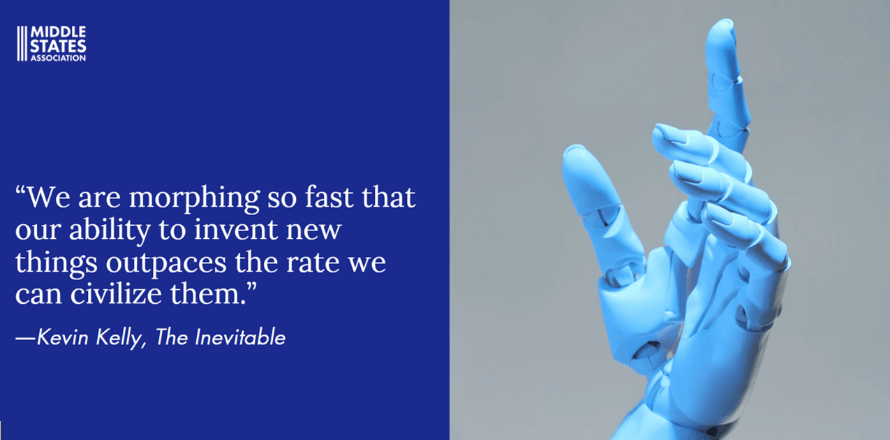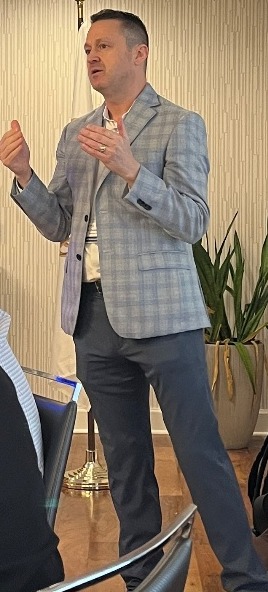Is Your Mission Statement AI Ready?
 I’m on the board of the National Council for Private School Accreditation (they made me treasurer, go figure!) and we recently focused on the impact of AI in schools and accreditation. Among other great speakers, I got to hear Christian Talbot, the President of Middle States Association, as well as an upcoming keynote speaker at the MISBO Annual Conference in Nashville. The title of his talk was AI and the Future of Accreditation: Learning to Play Jazz. Christian is a former head of school, a really big thinker, and through Middle States, has launched the Responsible AI In Learning (RAIL) endorsement for schools. There are currently 75+ RAIL schools in 30 countries on 6 continents serving 60,000+ students. One of his central points is that we have to begin to realize that artificial intelligence is no longer a futuristic concept, it is becoming embedded in the way we learn, work, and interact with the world.
I’m on the board of the National Council for Private School Accreditation (they made me treasurer, go figure!) and we recently focused on the impact of AI in schools and accreditation. Among other great speakers, I got to hear Christian Talbot, the President of Middle States Association, as well as an upcoming keynote speaker at the MISBO Annual Conference in Nashville. The title of his talk was AI and the Future of Accreditation: Learning to Play Jazz. Christian is a former head of school, a really big thinker, and through Middle States, has launched the Responsible AI In Learning (RAIL) endorsement for schools. There are currently 75+ RAIL schools in 30 countries on 6 continents serving 60,000+ students. One of his central points is that we have to begin to realize that artificial intelligence is no longer a futuristic concept, it is becoming embedded in the way we learn, work, and interact with the world.
At independent schools, the mission statement is sacred. It is the distilled essence of institutional identity, a touchstone for decisions about culture, curriculum, hiring, facilities planning, and even crisis management. But as artificial intelligence becomes a defining force in the world our students are entering, a timely question has emerged that Christian posed to us in the meeting: Is your mission statement still relevant in the age of AI?
 There will always be a gap between a school’s mission and a school’s mission statement. A well-crafted mission statement can’t possibly capture every nuance of culture that exists within a school, but it should have face validity, meaning that most people should understand it mostly the same way. The best mission statements are grounded in timeless values such as empathy, curiosity, integrity, resilience, which should be universally understood. They don’t expire with technological change, but they do deserve to be reexamined when the world undergoes a tectonic shift, and AI may be just that.
There will always be a gap between a school’s mission and a school’s mission statement. A well-crafted mission statement can’t possibly capture every nuance of culture that exists within a school, but it should have face validity, meaning that most people should understand it mostly the same way. The best mission statements are grounded in timeless values such as empathy, curiosity, integrity, resilience, which should be universally understood. They don’t expire with technological change, but they do deserve to be reexamined when the world undergoes a tectonic shift, and AI may be just that.
Over the past few years, we’ve watched AI move from sci-fi curiosity to classroom reality (my personal favorite is the Vulcan Bullies scene from the 2009 Star Trek reboot). Students are using AI to brainstorm essays and code simulations. Teachers are incorporating it into lesson planning. Operations leaders are using it as a thought partner, researcher, and work accelerator. School leaders are wrestling with ethical dilemmas and policy decisions that didn’t exist two years ago. At MISBO, we are using AI to help streamline workflows, improve our communications, see insights from disparate pieces of information – all with an eye of fulfilling our mission of connecting independent school professionals and delivering exceptional value to enrich learning. We are even about to launch an AI Basic Course for operational leaders to help you develop an AI mindset.
Many independent school mission statements reflect the late 1990s and early 2000s, when “college and career readiness” and “21st-century learning” were forward-thinking. But the future arrived faster than expected, and it looks more like ChatGPT than flying cars. If your mission focuses on content mastery without addressing discernment, or mentions technology only vaguely, it may be out of sync. In a world where students can ask AI to summarize Plato in seconds, education must center on judgment, creativity, and critical thinking, ethical reasoning, and the ability to navigate complexity and ambiguity.
One of my mentors always said the right time to do the right thing is right now! So, why not ask yourself Christian’s question: is your mission statement still relevant in the age of AI? And maybe ask some more questions: Are we preparing students for their future or for our past? Does our mission explicitly support the development of uniquely human capabilities that will be even more essential in an AI-infused society?
A personal highlight this summer was co-presenting at a conference with my son, Owen. He suggested we frame ourselves as an AI optimist (me!) and an AI pessimist (him). We encouraged the audience to reflect on what makes us uniquely human; the traits AI can’t replicate: empathy, judgment, creativity, and leadership under uncertainty. These are the skills that define purpose-driven humans, and these are the areas where independent schools already excel (and I think Owen does too). Relevant and strong missions celebrate those attributes and make them central to the educational experience.
Here are some questions to ask framed around your core identity and the intersection of your mission, values, and AI.
Relevance Check: determine whether your mission stands the test of time and technology.
- Does your mission reflect timeless values or time-bound processes? A mission grounded in enduring human qualities (like integrity, curiosity, and empathy) is more adaptable than one tied to specific tools or trends.
- Does your mission emphasize human skills AI can't replace? Empathy, ethical reasoning, adaptability, and creativity are future-proof skills.
- Does your mission acknowledge the importance of change and lifelong learning? A relevant mission empowers students to embrace uncertainty and prepare for roles that may not yet exist.
Intersectionality: think about how AI intersects with your core values.
- Would your current mission still feel meaningful if AI handled much of the academic content delivery?
- Does your mission prepare students to make good decisions in a world of deepfakes and misinformation?
- Is your mission helping them become the kind of thinkers and citizens who will lead humanely and wisely, regardless of what tools exist?
I love a good rubric (ask me about the chocolate chip cookie rubric), so I took a stab at creating something simple to get the assessment conversation started. I used traditional, transitional, responsive, and visionary as the x axis labels and mission language, faculty understanding, operations professionals, student preparation, and community engagement as the y axis dimensions to address. Schools at the traditional level may find their missions focused on academic content or college preparation with little acknowledgment of future shifts. Those in the transitional category may include broader learning goals but haven’t fully considered how AI changes the landscape. Responsive schools likely mention adaptability, ethics, and discernment, while visionary schools are using their mission to frame what it means to be human in an increasingly machine-mediated world. Change the terms to suit your school’s idiolect as you see fit.
Rubric: Mission Readiness in the Age of AI
| Traditional | Transitional | Responsive | Visionary | |
| Mission Language | Focuses on content mastery, tech use, and college/career prep; no reference to future uncertainty or ethics. | Includes lifelong learning or 21st-century skills, but vague on adaptability or discernment in the face of AI. | Explicitly values ethics, adaptability, and critical thinking in an evolving world. | Frames education as deeply human work in a machine-saturated age; challenges students to lead through change. |
| Faculty Understanding | Sees AI as a classroom disruption or trend; professional development rarely touches on it. | Growing curiosity among faculty; a few early adopters but limited systemic understanding. | Faculty actively engage with AI's implications and integrate mission alignment into teaching practice. | Faculty lead conversations about human-AI balance; school invests in ongoing reflection and innovation. |
| Operations Professionals | Operations staff are not engaged with AI; rely on manual or outdated processes. | Exploring tools like chatbots or resume screeners, but without strategic integration. | Some AI tools are used (e.g., enrollment analytics, advancement automation) with mission-focused discussion. | Operations teams lead in using AI for efficiency and insight; practices support a human-centered, strategic mission. |
| Student Preparation | Students are taught knowledge and digital skills, but without emphasis on AI’s ethical or societal implications. | Some exposure to AI tools or awareness, but preparation is reactive or isolated. | Students explore AI’s potential and limitations; curriculum promotes discernment, judgment, and collaboration. | Students are empowered to question, lead, and innovate ethically within an AI-influenced world. |
| Community Engagement | Families and trustees are largely unaware of AI's impact on education or mission alignment. | AI is mentioned occasionally in conversations, but without a shared sense of urgency or alignment. | Community conversations are emerging; mission is being re-interpreted through the lens of change. | Community embraces ongoing dialogue about education in the AI era; mission is a living guidepost. |
Mission statements are pretty much tripartite: they say something about your foundational beliefs, something about how your school operates, and something about how your students will contribute to their own futures. What matters most is that the mission remains alive, not just as a paragraph on a website, but as an active lens for shaping curriculum, making hiring decisions, engaging in student life, and building community culture. If the mission still rings true in this new AI era, celebrate it. If it feels a little wobbly, now is the time to tune it up. This work is not only strategic; it’s deeply affirming. It ensures that your school continues to stand for something meaningful, something timeless, but also timely. And when you want to go even further, check out the RAIL endorsement from Middle States.
Some books I thought about when writing this blog.
Robot-Proof: Higher Education in the Age of Artificial Intelligence
